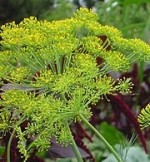D ill is a cool weather annual native to northern Africa and the Arabian peninsular but is widely grown in Europe where its seeds and leaves are used as a culinary herb. Plants grow 3-5′ tall and have stiff hollow stems and fragrant, blue-green leaves that are pinnately divided into fine segments. In mid summer flat, compound umbels up to 10″ across appear bearing small yellow flowers that give way to aromatic seeds.
ill is a cool weather annual native to northern Africa and the Arabian peninsular but is widely grown in Europe where its seeds and leaves are used as a culinary herb. Plants grow 3-5′ tall and have stiff hollow stems and fragrant, blue-green leaves that are pinnately divided into fine segments. In mid summer flat, compound umbels up to 10″ across appear bearing small yellow flowers that give way to aromatic seeds.
The Bible mentions an herb, ἄνηθον in Mathhew 23.23. The word has been translatd from the koine Greek as anise or dill, but most translators use the word dill, indentified as Anethum graveolens. The passage is part of an address by Jesus to the crowd and his disciples. He is using the tithing of three herbs by the religious leaders as an example of how they are observing the rules about little things while ignoring the important matters. In Luke’s version of this event (Luke 11.42), Luke uses rue instead of dill.
Mathew 23.23 “Woe to you, teachers of the law and Pharisees, you hypocrites! You give a tenth of your spices—mint, dill and cumin. But you have neglected the more important matters of the law—justice, mercy and faithfulness. You should have practiced the latter, without neglecting the former.
Dill plants like cool temperatures, full sun, and moderately rich, medium moist, well-drained soil . They are susceptible to horn worms, aster wilt, and Alternaria blight. Propagation is by seed in place because seedlings resent transplaning.
The genus name, Anethum, is from the Greek name for the plant. The specific epithet, graveolens, is probably related to the Latin word gravis meaning heavy, and refers to the scent.